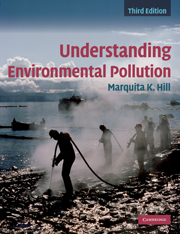Book contents
- Frontmatter
- Contents
- Preface
- Acknowledgements
- List of abbreviations and acronyms
- 1 Understanding pollution
- 2 Reducing risk, reducing pollution
- 3 Chemical toxicity
- 4 Chemical exposures and risk assessment
- 5 Air pollution
- 6 Acid deposition
- 7 Global climate change
- 8 Stratospheric ozone depletion
- 9 Water pollution
- 10 Drinking-water pollution
- 11 Solid waste
- 12 Hazardous waste
- 13 Energy
- 14 Persistent, bioaccumulative, and toxic
- 15 Metals
- 16 Pesticides
- 17 Pollution at home
- 18 Zero waste, zero emissions
- 19 Chemistry: some basic concepts
- Index
- References
12 - Hazardous waste
Published online by Cambridge University Press: 05 June 2012
- Frontmatter
- Contents
- Preface
- Acknowledgements
- List of abbreviations and acronyms
- 1 Understanding pollution
- 2 Reducing risk, reducing pollution
- 3 Chemical toxicity
- 4 Chemical exposures and risk assessment
- 5 Air pollution
- 6 Acid deposition
- 7 Global climate change
- 8 Stratospheric ozone depletion
- 9 Water pollution
- 10 Drinking-water pollution
- 11 Solid waste
- 12 Hazardous waste
- 13 Energy
- 14 Persistent, bioaccumulative, and toxic
- 15 Metals
- 16 Pesticides
- 17 Pollution at home
- 18 Zero waste, zero emissions
- 19 Chemistry: some basic concepts
- Index
- References
Summary
“I've worked with indigenous people on all continents but Antarctica, and one thing they all agree on is the Earth is sacred. We're the only ones who look at it as a commodity.”
Dr. Paul Cox, ethnobiologistA hazardous waste is one that is either ignitable, corrosive, reactive, toxic, or more than one of these. As with municipal solid waste, hazardous waste is a small percentage of the more than 12 billion tons (10.9 billion tonnes) of total waste that the United States generates each year. But hazardous waste has been abandoned at many thousands of sites in the United States, and around the world. At these sites, hazardous substances may contaminate soil, seep into groundwater, or run off into nearby water, and evaporate into the air. Section I of this chapter examines hazardous waste (HW) characteristics, locales of HW sites, and who generates HW. Section II returns to the Waste Management Hierarchy (WMH) as applied to hazardous waste. Section III deals with how human exposure occurs and how the risks of HW sites are evaluated. Section IV examines how to reduce the risk of HW sites, and examines cleanup methods including bioremediation. Section V moves on to HW dumping in impoverished nations and the international accord negotiated to combat this practice. One waste still moving into these countries is a stream of electronic discards. We look at how we can reduce that flow.
- Type
- Chapter
- Information
- Understanding Environmental Pollution , pp. 348 - 373Publisher: Cambridge University PressPrint publication year: 2010

